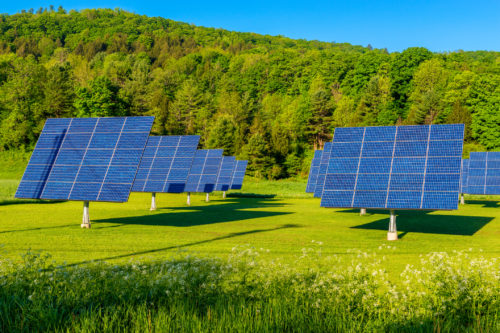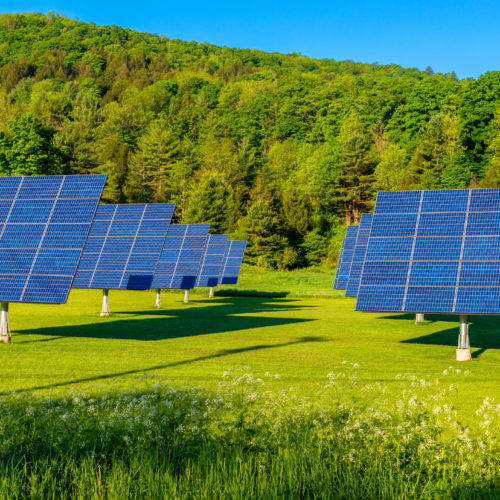Solar Panels in a Field in Woodstock, Vermont, USA on early spring day.

How to Plan for a More Distributed Grid, Part Three
This is the third blog in a three-part series. The first and second blogs are available here and here.
One of the main themes at the 2018 Rocky Mountain Institute Electricity Innovation Lab (e–Lab) Accelerator event, held in Sundance, Utah, in May, was distributed grid infrastructure—the use of least-cost portfolios of distributed energy resources (DERs) to complement traditional electric grid infrastructure or to defer or avoid investments in it. These combinations, also known as clean energy portfolios (CEPs), consist of resources like utility-scale and distributed wind and solar generation, battery energy storage, energy efficiency, and demand-response technologies used in place of new power plants or transmission and distribution infrastructure.
In a recent report, The Economics of Clean Energy Portfolios, RMI showed that new-built CEPs are already an economically attractive alternative to new gas-fired power plants in most cases and are likely to beat just the operating costs of efficient gas-fired power plants within the next two decades. Four teams came to Accelerator 2018 to work on distributed grid infrastructure projects. These are their stories.
Planning for DERs when You Don’t Have To
A team composed largely of representatives of Southern Company, an American gas and electric utility holding company based in the southern United States, came to Accelerator because they saw the rapidly dropping price of DERs, and wanted to plan for the adoption of DERs as a non-wires alternative in the absence of a regulatory mandate to do so. While most of the states where Southern Company serves customers don’t have any renewable portfolio standards, including Mississippi, Alabama, Florida, and Georgia, where it is headquartered, Georgia Power has developed one of the largest voluntary solar portfolios in the nation.
Southern Company’s utilities in the southeast have already deployed or committed to over 2,000 MW of renewable energy and want to continue to expand their utilization of renewable energy to meet their customers’ expectations. The declining price and improvements in technology could make DERs attractive to provide the best overall value to Southern Company customers. Furthermore, Southern Company has very large customers in businesses like data storage that need very high levels of reliability, which energy storage can be vital to providing.
As the holding company, it is Southern Company’s role to do research and development and establish best practices to guide its subsidiaries as they set policies with each state’s regulators and each utility’s customers. And the company is aware that business as usual won’t be best practice for long. Steps must be taken now to develop the tools and processes for integrating DERs as a non-wires alternative and modernize the grid to meet Southern Company’s carbon reduction strategy.
The team, which included representatives from nonprofits and technology providers, came to a good understanding of what non-wires alternatives made sense for them. They discussed how distributed generation could provide even better service by increasing resilience, reliability, and power quality. Part of Southern Company’s service area is an island in the Gulf of Mexico that is often impacted by hurricanes, so the resilience benefits of storage would be particularly excellent there. And placing generation and storage at the distribution edge wouldn’t just help with things like voltage support, it would also avoid some investment in transmission and distribution infrastructure. Battery prices are declining, and storage could soon be an economically optimal solution in more and more places. Investments in DERs could also help Southern Company reach its decarbonization goals.
Because Southern Company operates 11 regulated utilities serving 9 million customers in nine states, there are a lot of stakeholders to bring on board to effect company-wide change. The team’s facilitator, RMI senior associate Kevin Brehm, explained that the team “thought about how to approach key decision makers so that they can update the company’s planning processes to include non-wires alternatives.” They determined that the first step was to draft a paper to lay out the business case for adding a portfolio of DERs across the company. This will be the basis for an internal effort to consider and weigh the scale and complexity of the changes they might propose.
Technology and the electric industry are changing as the clean energy revolution progresses, and large players like Southern Company are on the front lines. Proactive planning like theirs stands to benefit the company, the grid, and its customers.
All 13 teams at e–Lab Accelerator this year came to work on issues at the grid edge, and the four teams highlighted in this three-part blog series made progress on different aspects of how distributed grid infrastructure can make a difference there. Such infrastructure holds great promise, and we look forward to hearing how its development furthers the energy revolution.
The work of the other two teams is discussed in other blogs. The first blog in this series is available here, and the second here.


